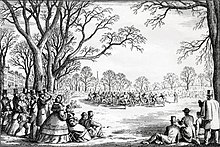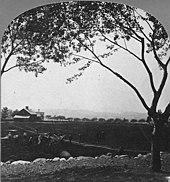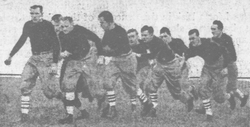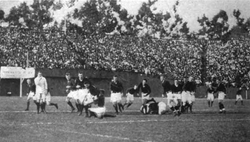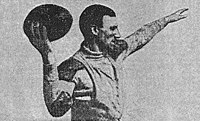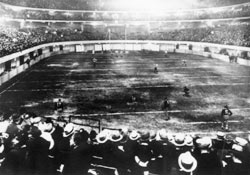Early history of American football
[1][2] In the late nineteenth and early twentieth centuries, gameplay developments by college coaches such as Eddie Cochems, Amos Alonzo Stagg, Parke H. Davis, Knute Rockne, John Heisman, and Glenn "Pop" Warner helped take advantage of the newly introduced forward pass.
This allusion, slight as it may be, is sufficient unto the antiquary to indicate that some sort of game with a ball existed as early as 750 years before the Christian era, the epoch customarily assigned to the Book of Isaiah.
A more specific allusion of the same period, however, is the passage in the Sixth Book of the Odyssey of Homer familiar to all school boys: "Then having bathed and anointed well with oil they took their midday meal upon the river's banks and anon when satisfied with food they played a game of ball.
For example, New Zealand had Kī-o-rahi, Australia marn grook, Japan kemari, China cuju, Georgia lelo burti, the Scottish Borders Jeddart Ba' and Cornwall Cornish hurling, Central Italy Calcio Fiorentino, South Wales cnapan, East Anglia Campball and Ireland had caid, which an ancestor of Gaelic football.
King Edward II was so troubled by the unruliness of football in London that, on April 13, 1314, he issued a proclamation banning it:[citation needed] Forasmuch as there is great noise in the city caused by hustling over large balls from which many evils may arise which God forbid; we command and forbid, on behalf of the King, on pain of imprisonment, such game to be used in the city in the future.In 1531, Sir Thomas Elyot wrote that:[11] in like wise foote balle, wherin is nothinge but beastly furie and exstreme violence.These antiquated games went into sharp decline in the 19th century when the Highway Act 1835 was passed banning the playing of football on public highways.
[14] In 1586, men from a ship commanded by an English explorer named John Davis, went ashore to play a form of football with Inuit (Eskimo) people in Greenland.
Inasmuch as rugby football had been transplanted to Canada from England, the McGill team played under a set of rules which allowed a player to pick up the ball and run with it whenever he wished.
[citation needed] Despite their effectiveness, the flying wedge, "V-trick formation" and other tactics which involved interlocking interference, were outlawed in 1905 through the efforts of the rule committee led by Parke H. Davis, because of its contribution to serious injury.
[37] The 1885 season was notable for one of the most celebrated football plays of the 19th century – a 90-yard punt return by Henry "Tillie" Lamar of Princeton in the closing minutes of the game against Yale.
[38] Lamar streaked down the left sideline, until hemmed in by two Princeton players, then cut sharply to the middle of the field, ducking under their arms and breaking loose for the touchdown.
For the first time, the game was played on one of the campuses instead of at a neutral site, and emerged as a major social event, attracting ladies to its audience as well as students and male spectators.
Joseph M. Reeves had a crude leather helmet made by a shoemaker in Annapolis and wore it in the game after being warned by his doctor that he risked death if he continued to play football after suffering an earlier kick to the head.
Eckersall was selected as the quarterback for Walter Camp's "All-Time All-America Team" honoring the greatest college football players during the sport's formative years.
[116] On December 25, 1894, Amos Alonzo Stagg's Chicago Maroons agreed to play Camp's Stanford football team in San Francisco in the first postseason intersectional contest, foreshadowing the modern bowl game.
In May 1900, Fielding H. Yost was hired as the football coach at Stanford University,[136] and, after traveling home to West Virginia, he arrived in Palo Alto, California, on August 21, 1900.
Messrs Carney, Whittaker, Layton and others, who at that time constituted a majority of the male population of the University, called a meeting of the campus boys in the old medical building.
A Scottish author wrote in 1908 that[141] The British newspaper reader is apt to obtain his idea of the importance and standing of American universities chiefly from the accounts of their athletic prowess, which was measured roughly, a few years ago, by the number of students who were killed or maimed in the course of a season's football.From its earliest days as a mob game, football was a violent sport.
[142] One of the major problems was the popularity of mass-formations like the flying wedge, in which a large number of offensive players charged as a unit against a similarly arranged defense.
Bradbury Robinson, playing for visionary coach Eddie Cochems at St. Louis University, threw the first legal pass in a September 5, 1906, game against Carroll College at Waukesha.
Other important changes, formally adopted in 1910, were the requirements that at least seven offensive players be on the line of scrimmage at the time of the snap, that there be no pushing or pulling, and that interlocking interference (arms linked or hands on belts and uniforms) was not allowed.
[153] Star players that emerged in the early 20th century include Jim Thorpe, Red Grange, and Bronko Nagurski; these three made the transition to the fledgling NFL and helped turn it into a successful league.
The end Knute Rockne and quarterback Gus Dorais made innovative use of the forward pass, still at that point a relatively unused weapon, to defeat Army 35–13 and helped establish the school as a national power.
[162] Henry L. Williams, an 1891 graduate of Yale, had earlier repeatedly offered to mentor his alma mater in the formation, but was rebuffed because the Elis would "not [take] football lessons from a Western university.
[183] Utilizing the "jump shift" offense, John Heisman's Georgia Tech Golden Tornado won 222 to 0 over Cumberland on October 7, 1916, at Grant Field in the most lopsided victory in college football history.
Among a long list, his most famous and lasting inventions include trick plays such as the end-around and the Statue of Liberty, maneuvers such as shifts and motion, equipment such as hip pads, and the first book on football with diagrams.
A famous story of Stagg from his older days tells how he would keep his front lawn in immaculate shape, so that the kids living in his neighborhood would have a good surface to play football on.
[208] One of his most famous stints was at the Carlisle Indian Industrial School, where he coached Jim Thorpe, who went on to become the first president of the National Football League, an Olympic Gold Medalist, and is widely considered one of the best overall athletes in history.
[citation needed] Knute Rockne rose to prominence in 1913 as an end and chemistry student for the University of Notre Dame, then a largely unknown Midwestern Catholic school.
In the early 20th century, football began to catch on in the general population of the United States and was the subject of intense competition and rivalry, albeit of a localized nature.
Although payments to players were considered unsporting and dishonorable at the time, a Pittsburgh area club, the Allegheny Athletic Association, of the unofficial western Pennsylvania football circuit, surreptitiously hired former Yale All-American guard Pudge Heffelfinger.





